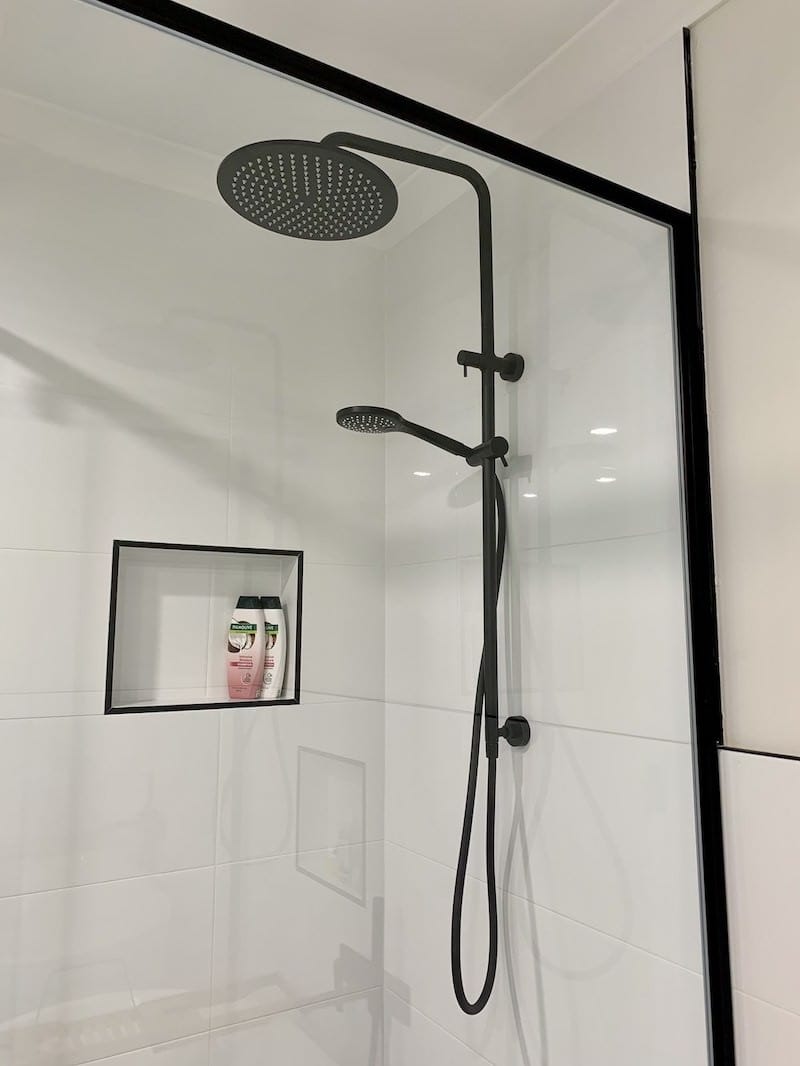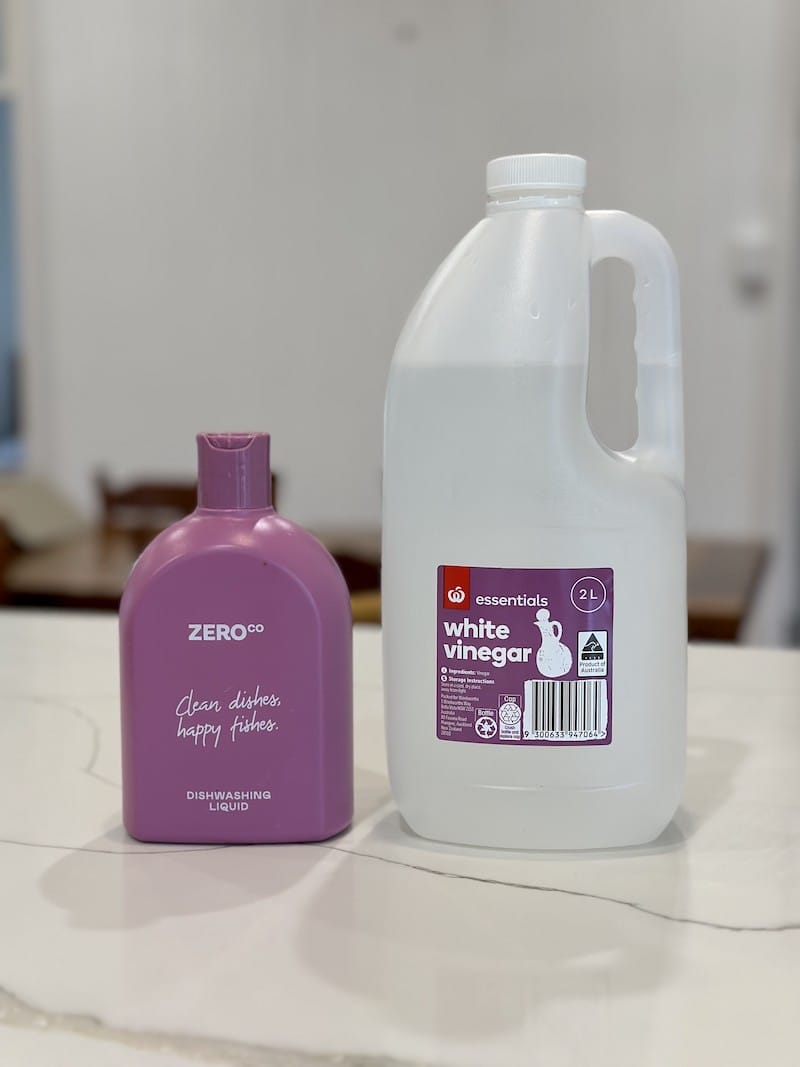You’d think your bathroom tiles would stay clean because of all the soap and water!
Unfortunately, those two things do contribute to a build-up of soap scum, limescale, and other dirt on your walls and floors. So when you’re cleaning your shower, it’s essential to thoroughly wash the shower tiles.
The problem? It usually involves scrubbing.
No worries, though – you can absolutely learn how to clean shower tiles without scrubbing. There are several options for homemade cleaning solutions to use:
- Baking soda and hydrogen peroxide
- White vinegar and dish detergent
- Borax
- Oxygen bleach
- Steam cleaning
No point in feeling squeaky clean in the shower if the tiles are dirty! Pick your DIY cleaner and get ready to put in some elbow grease – only a little bit, though.
What Causes Dirty Shower Tiles?
Bathrooms often use ceramic or porcelain tiles for shower walls and floors. These materials are porous, although they’re usually finished with a glaze to protect them.
Still, the surface of your tiles will collect dirt and grime over time, from things like:
- Hard water (which leads to limescale and other stains)
- Soap scum from soap, shampoo, etc.
- General dirt particles and dust
How Often to Clean Shower Tiles

Like the rest of your bathroom fixtures, you should clean shower tiles once a week.
If you find any noticeable stains on the shower floor or walls, treat them immediately.
How to Clean Shower Tiles Without Scrubbing
Just as when cleaning tiles in general, you can start by breaking out the vacuum cleaner.
Clean up the loose dirt from the floor so you don’t scrub it into the tiles and grout.

1. Using baking soda and hydrogen peroxide
For this cleaning solution, it’s important to remember you should not mix anything else. Some substance combinations are dangerous for your health.
Mix equal parts baking soda and hydrogen peroxide into a thick paste. Apply the mixture with a sponge to clean shower tiles without scrubbing.
Let the paste work its magic for an hour, then rinse the tiles with warm water.
NOTE: Do not store any remaining mixture. Dispose of it immediately. Any container could burst or break from the build-up of carbon dioxide.
2. Using white vinegar and dishwashing detergent

Vinegar is a powerful cleaning solution for many surfaces around your home. The acid will cut through dirt, minimising the need for scrubbing.
Add a few drops of dish soap into a spray bottle full of vinegar for a homemade cleaner. Saturate the tiled surface and let it sit for about an hour.
Rinse the shower tiles with warm water afterwards, then let the tiles dry.
3. Using borax
Again, be careful with what you mix into the borax! Water and vinegar are both fine, but it’s always good to be cautious.
Add hot water to borax until you create a paste. You can also mix in baking soda for extra cleaning power.
Take your alkaline cleaner and apply it to your shower tiles. Let it sit for 30–60 minutes before rinsing off.
4. Using oxygen bleach
This is a milder solution than regular bleach, and it’s great for getting your shower clean.
Mix three tablespoons of oxygen bleach into a bucket of warm water (about 9 litres).
Saturate the shower tiles with the solution and let it sit for at least 15 minutes. You can use a spray bottle to make this easier.
Wash off the mixture with cold water.
Oxygen bleach is also a good choice to remove stains from tile surfaces.
5. By steam cleaning

This is the best option for lighter cleaning!
Simply run a hot shower for 5–10 minutes so steam builds up. It will loosen the dirt and grime, which you can rinse away.
You can also use a steam cleaner – just be mindful of the finish of your ceramic tiles.
Can You Use a Pressure Washer to Clean Shower Tiles?
Some viral internet trends have brought up using a pressure washer to clean shower tiles without scrubbing.
A cordless pressure washer can blast water at the tile surfaces and remove dirt, stains, and grime.
Does it work? Kind of.
While the pressure of the water does remove dirt, you’re only cleaning with water. This may be less effective than using other cleaning products such as baking soda or borax.
The pressure washer could also damage the grout lines, or cause excess water to seep into the grout and potentially develop mould.
Lastly, since cordless pressure washers have limited battery power, you may need to recharge during cleaning. This could make the process take far longer than simply cleaning using the different solutions.
Cleaning Dirty Grout
Cleaning grout is just as important as cleaning your shower tiles. Dirty shower grout will make the whole surface look unclean, no matter how well you’ve washed the tiles.
There are several techniques to clean shower grout without scrubbing. You can mix 1/2 cup of baking soda with 1/4 hydrogen peroxide into a paste, then apply that to the grout lines.
Let the mixture sit for 10 minutes before rinsing it off.
For cleaning grout stains, you can use a diluted bleach solution. If you want to avoid harsh chemicals, mix equal parts vinegar and hot water.
Essential Bathroom Maintenance
Don’t forget to clean the shower glass and bathroom door too! Limescale and soap residue also build up on the glass, so you’ll need to wash that alongside the rest of your shower.
To reduce the accumulation of dirt and residue in your shower, you can keep white vinegar in a spray bottle and a squeegee handy. That way, you can quickly rinse the walls after a shower.
Keep your bathroom well-ventilated to deter the development of mould and mildew. Either crack open the windows or run the exhaust fan while you’re showering.
Scrubbing is exhausting, but these homemade solutions can help you clean your shower tiles without scrubbing. That’ll save you a lot of effort that could go into a lot of other things!
Otherwise, if you really want to save your energy – ask professional cleaners to clean your bathroom.

